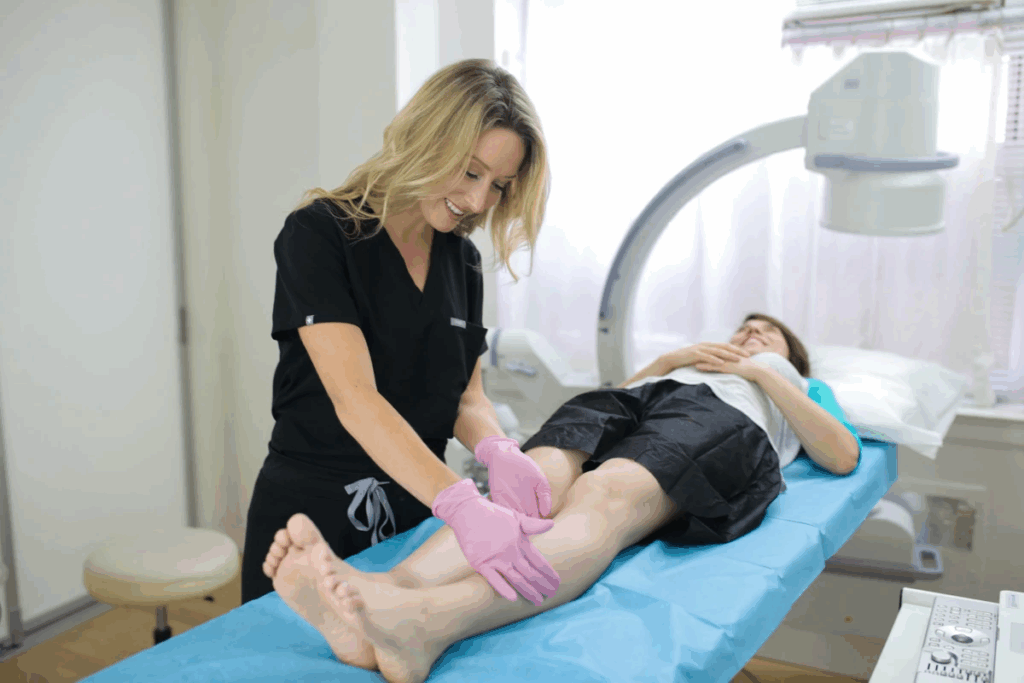Last Updated on October 23, 2025 by mcelik

Recovering from radiofrequency ablation is more than just resting. At Liv Hospital, we stress the need for physical therapy. It helps patients get back to normal and eases pain.
Walking, cycling, and yoga are good for RFA recovery. They help lessen leg pain and improve movement. Our physical therapy plans are made to speed up healing and achieve better results.
Adding specific exercises to your recovery plan boosts your body’s healing. It helps you get back to your daily activities faster.

Knowing how radiofrequency ablation (RFA) works is key to understanding what to expect and how to recover. This procedure is a minimally invasive way to treat chronic pain. It uses heat to target specific nerves, which helps reduce pain signals to the brain.
RFA uses electrical currents to generate heat. This heat is then used to target and disable specific nerves that send pain signals. It’s often chosen for those who haven’t found relief from chronic pain through other methods.
RFA is used to treat several chronic pain conditions, including:
By focusing on the nerves that carry pain, RFA can offer significant relief to those suffering from these issues.
Right after RFA, patients might feel a variety of effects, such as:
| Effect | Description |
| Pain Relief | Some patients may feel pain relief right away, while others might take a few weeks to notice it fully. |
| Soreness | Mild soreness or discomfort at the treatment site is common and usually goes away in a few days. |
| Numbness | Temporary numbness or tingling sensations may occur due to the effect of the procedure on the nerves. |
Patients need to follow the post-procedure instructions closely. This helps ensure the best recovery and avoids any complications.

Rehabilitation after radiofrequency ablation is not just helpful – it’s key to getting the best results. Physical therapy is vital in improving RFA outcomes. It tackles the musculoskeletal issues that led to the condition in the first place.
Physical therapy after radiofrequency ablation boosts the treatment’s success. It improves mobility, cuts down pain, and strengthens muscles. This helps in:
Rehabilitation is not a one-size-fits-all approach. Our physical therapists create custom exercise plans for each patient. These plans are based on their unique needs and treatment areas.
The best time to start physical therapy after RFA varies. It depends on the treatment area and the patient’s health. Usually, we suggest starting within 1-2 weeks after the procedure.
| Post-RFA Timeline | Rehabilitation Focus |
| 1-2 weeks | Initial assessment, pain management, and gentle mobilization |
| 2-6 weeks | Progressive strengthening, flexibility exercises |
| 6+ weeks | Advanced strengthening, functional training |
It’s important to have realistic recovery hopes. RFA can offer a lot of pain relief, but it doesn’t mean you won’t feel pain again. Our physical therapists help set realistic goals and strategies for long-term benefits.
Combining RFA with a structured physical therapy program boosts success rates. Patients can enjoy a better quality of life.
Pain after radiofrequency ablation can worry patients. It’s key to know what pain is normal and what’s not. RFA aims to lessen chronic pain, but some discomfort is usual after the treatment.
There are many reasons for pain after RFA. The treatment heats nerve endings to block pain signals, which can cause temporary pain. Inflammation and irritation at the procedure site are common causes.
Some patients might also get neuritis, an inflammation of the nerves. This can lead to pain. Knowing these reasons can help patients prepare for and manage their recovery better.
Neuritis is a possible side effect of RFA, happening when nerves get irritated. Symptoms include pain, numbness, or tingling. Usually, neuritis is short-lived and goes away by itself.
| Symptoms of Neuritis | Management Strategies |
| Pain | Medication, rest |
| Numbness | Physical therapy, monitoring |
| Tingling | Avoiding exacerbating activities |
While some pain after RFA is normal, not all pain needs medical help. If you have severe pain, increasing pain, or pain with fever or swelling, see your doctor.
Watching how long your pain lasts is also important. If pain lasts longer than expected, talk to your healthcare provider.
Before starting any exercise after Radiofrequency Ablation, it’s important to think about a few things. Make sure to talk to your healthcare provider first.
Talking to your healthcare provider before starting any exercise is key. They can give you advice that fits your specific situation. This includes your health, the area treated, and more.
Key discussion points with your healthcare provider should include:
A good warm-up is vital before exercising after RFA. It boosts blood flow, reduces muscle stiffness, and gets your body ready for activity.
| Warm-Up Activity | Duration | Benefits |
| Light Cardio (e.g., walking) | 5-10 minutes | Increases heart rate and blood flow |
| Dynamic Stretching | 5 minutes | Improves flexibility and range of motion |
It’s important to listen to your body after exercising after RFA. If you feel more pain or discomfort, stop right away. Then, talk to your healthcare provider.
Pay attention to your body’s signals. You might need to change the intensity, duration, or type of exercises you’re doing.
Gentle stretching routines are key after radiofrequency ablation. They help increase flexibility and reduce stiffness. These exercises help patients move better and feel less pain. Gentle stretching is important as we recover.
Upper body stretches are vital for keeping the neck, shoulders, and arms flexible. Some good stretches include:
These stretches help reduce tension and improve movement. Experts say gentle and consistent stretching can greatly improve flexibility and reduce pain.
Lower body stretches target the hips, knees, and legs, which often get affected by radiofrequency ablation. Some recommended stretches are:
Proper technique is essential to avoid injury and get the most from these stretches.
When doing gentle stretches, it’s important to follow the right technique and hold for the right amount of time. Hold each stretch for 15-30 seconds and do it 2-3 times. Remember to breathe naturally and don’t bounce or force beyond what feels comfortable.
Listening to your body is key; if you feel pain or discomfort, stop right away. Always talk to your healthcare provider before starting gentle stretching after radiofrequency ablation. This ensures a safe and effective recovery.
Low-impact walking programs are key in a recovery plan after Radiofrequency Ablation (RFA). Walking is gentle yet effective for regaining strength and mobility. It’s a low-impact exercise that helps in rehabilitation.
To make walking part of your recovery, start with a progressive schedule. Begin with short walks of 10-15 minutes, 2-3 times a day. This is based on your comfort and your doctor’s advice. Increase the walk time and frequency as you get stronger.
Proper walking form is important to avoid straining your body after RFA. Here are some tips:
Some people may feel leg pain after RFA. This can be managed with proper walking and exercise. If you feel pain, try these:
By adding low-impact walking to your recovery plan, you can speed up your healing after RFA. This helps you get back to your normal activities faster and more effectively.
After radiofrequency ablation, water therapy can really help with healing. Aquatic therapy is great for getting back strength and mobility. It’s low-impact and very effective.
Water exercises help a lot with RFA recovery. They reduce pain and swelling, improve movement, and build muscle. The water’s buoyancy is gentle on joints, perfect for healing.
Key benefits of aquatic therapy include:
For swimming after RFA, some strokes are better than others. Start with easy strokes like the breaststroke or backstroke. They’re gentle and help you relax.
The right water exercises depend on where you had RFA. For lower back pain, try leg lifts or knee bends. For neck pain, gentle neck rotations are good.
| Treatment Area | Recommended Water Exercises |
| Lower Back | Leg lifts, knee bends |
| Neck | Gentle neck rotations, shoulder rolls |
| Knee | Water walking, leg swings |
Adding water therapy to your recovery plan can speed up healing. It can also make your RFA recovery better overall.
Core strengthening exercises are key to improving stability and reducing pain after back ablation therapy. Adding these exercises to your routine can help you recover better and live a better life.
In the early stages of recovery, gentle core activation is essential. Start with low-intensity exercises that work your core without straining your back too much.
Examples of Gentle Core Activation Exercises:
As you get better, increase the intensity of your core exercises. You can do this by adding more repetitions, sets, or resistance.
Progressive Core Strengthening Exercises:
Adjust your core exercises based on your pain level. If you’re in a lot of pain, start with very gentle exercises and gradually get more intense.
Modifying Exercises for Pain:
By adding these core exercises to your routine and adjusting them for your pain, you can improve your recovery after back ablation therapy. This will help you live a better life.
Recovering from cervical neck ablation needs a mix of rest and specific exercises. We suggest a gentle and step-by-step approach to physical therapy. This helps your healing journey.
Doing gentle neck exercises is key to keeping your neck flexible and avoiding stiffness after cervical neck ablation. These exercises should be done slowly and within a safe range of motion.
Building muscle around the cervical spine helps support your neck and boosts stability. Start with easy exercises and gradually make them harder.
To avoid making pain worse after cervical radiofrequency ablation, avoid heavy lifting, bending, or twisting. Keeping good posture and taking breaks often can also help.
By adding these targeted exercises to your recovery plan, you can improve your healing and lower the chance of problems after cervical neck ablation.
Recovering from radiofrequency ablation is not just about managing pain. It also means improving balance and moving better through exercises. As we get better, focusing on balance and movement is key. It helps us feel stable and do everyday things easily.
Balance exercises are vital for stability after RFA. They boost our sense of where our body is in space and strengthen our postural muscles. Simple exercises like:
Functional movements are exercises that help us do daily tasks better. They include:
Adding these movements to your routine can make daily tasks easier. It also improves your quality of life.
To get the most from balance and movement exercises, do them regularly. Start slow and get more challenging as you can. Always listen to your body and don’t overdo it.
Talking to your doctor or physical therapist about your exercises is a good idea. They can help make a plan that fits your needs and goals. This way, you can recover safely and effectively after radiofrequency ablation.
Radiofrequency ablation recovery is more than just the procedure. It also includes a detailed rehabilitation plan. This plan includes physical therapy and making lifestyle changes.
Following RFA recovery protocols is key. These protocols include gentle exercises and gradually increasing activity levels. For those with cervical radiofrequency ablation, healing the cervical cuff is vital for lasting success.
Patients can play a big role in their recovery by following the exercises and guidelines in this article. It’s important to work with healthcare providers to create a recovery plan that fits their needs.
Recovering from RFA is a complex process. With the right approach, patients can get the most out of their treatment. This can greatly improve their quality of life.
Radiofrequency ablation is a procedure that uses heat to kill specific nerves. This helps reduce or stop pain. It’s often used for chronic pain.
Physical therapy helps you recover faster and feel less pain. It makes you stronger and more flexible. This leads to better results.
When you can start exercising after RFA depends on your situation. Usually, you can start with light exercises a few days to a week after. Always check with your doctor first.
Some pain after RFA is normal. But too much pain could mean neuritis ,or the procedure didn’t work fully. If the pain is bad, call your doctor.
Stretching gently can make you more flexible and less stiff. It also helps with pain. Start slow and listen to your body.
Yes, walking is great for your heart and moving around after RFA. Start with short walks and get longer and harder, but keep good form.
Swimming and water therapy are good for recovery. They’re easy on your joints and muscles. Water helps with pain and mobility.
Strengthening your core helps your spine and posture. This can reduce back pain. Start with gentle exercises and get stronger slowly.
Doing gentle neck exercises and strengthening your neck can help after cervical RFA. Be careful not to make pain worse.
Balance training makes you more stable and less likely to fall. It helps you move better and feel more confident.
For leg pain after RFA, try gentle exercises and stretching. You might also need physical therapy. If pain gets worse, see your doctor.
If you have severe, getting worse, or ongoing pain, or if you see signs of infection or nerve damage, call your doctor right away.
Subscribe to our e-newsletter to stay informed about the latest innovations in the world of health and exclusive offers!
WhatsApp us